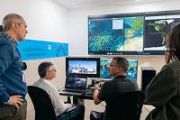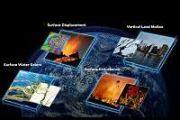
Copernical Team
SpaceX Axiom crew nears final training for first all-private mission to ISS
 NASA and Houston-based Axiom Space are in the final stages of training and preparation to launch the first all-private astronaut mission, Ax-1, to the International Space Station in late March, mission leaders said Monday.
But don't call the crew - three billionaires paying $55 million each - space tourists, Michael Lopez-Alegria, former astronaut and Ax-1 mission commander, said du
NASA and Houston-based Axiom Space are in the final stages of training and preparation to launch the first all-private astronaut mission, Ax-1, to the International Space Station in late March, mission leaders said Monday.
But don't call the crew - three billionaires paying $55 million each - space tourists, Michael Lopez-Alegria, former astronaut and Ax-1 mission commander, said du Tycoons bound for ISS aren't tourists, insists space company
 Three tycoons and an ex-NASA astronaut are all set for the first fully private voyage to the International Space Station next month - just don't call them tourists.
That's the word from Michael Lopez-Alegria, formerly of the US space agency and now commander of the Ax-1 mission, which will see the crew launch from the Kennedy Space Center on March 30 aboard a SpaceX Dragon, then spend eigh
Three tycoons and an ex-NASA astronaut are all set for the first fully private voyage to the International Space Station next month - just don't call them tourists.
That's the word from Michael Lopez-Alegria, formerly of the US space agency and now commander of the Ax-1 mission, which will see the crew launch from the Kennedy Space Center on March 30 aboard a SpaceX Dragon, then spend eigh Rocket Lab launches 2nd satellite for the Synspective SAR constellation
 Rocket Lab USA, Inc (Nasdaq: RKLB), a leading launch and space systems company, has successfully deployed a second Synthetic Aperture Radar (SAR) satellite to orbit for data and solutions provider Synspective, bringing the total number of satellites deployed by Rocket Lab to 110. 'The Owl's Night Continues" mission is Rocket Lab's 24th Electron launch.
"The Owl's Night Continues" mission w
Rocket Lab USA, Inc (Nasdaq: RKLB), a leading launch and space systems company, has successfully deployed a second Synthetic Aperture Radar (SAR) satellite to orbit for data and solutions provider Synspective, bringing the total number of satellites deployed by Rocket Lab to 110. 'The Owl's Night Continues" mission is Rocket Lab's 24th Electron launch.
"The Owl's Night Continues" mission w China establishes deep space exploration laboratory
 China's deep space exploration laboratory has been officially inaugurated, according to the China National Space Administration (CNSA).
Co-established by the CNSA, Anhui Province and the University of Science and Technology of China, the laboratory is headquartered in Hefei.
It will carry out science and technology research focusing on major national projects in the field of deep spa
China's deep space exploration laboratory has been officially inaugurated, according to the China National Space Administration (CNSA).
Co-established by the CNSA, Anhui Province and the University of Science and Technology of China, the laboratory is headquartered in Hefei.
It will carry out science and technology research focusing on major national projects in the field of deep spa China's new-generation rocket sends 22 satellites into space in record-setting mission
 China launched a Long March-8 rocket to place 22 satellites in space on Sunday, setting a domestic record for the most spacecraft launched by a single rocket.
The rocket blasted off at 11:06 a.m. (Beijing Time) at the Wenchang Spacecraft Launch Site in the southern Hainan Province before sending the satellites into preset orbit.
These satellites will then be released in 12 groups. Th
China launched a Long March-8 rocket to place 22 satellites in space on Sunday, setting a domestic record for the most spacecraft launched by a single rocket.
The rocket blasted off at 11:06 a.m. (Beijing Time) at the Wenchang Spacecraft Launch Site in the southern Hainan Province before sending the satellites into preset orbit.
These satellites will then be released in 12 groups. Th Intelsat teams with Microsoft to demonstrate private cellular network
 Intelsat, operator of one of the world's largest and most advanced integrated satellite and terrestrial networks, has announced the successful demonstration of a first of its kind private cellular network with Microsoft Azure Private Multi-Access Edge Compute and FlexEnterprise, Intelsat's satellite-based global connectivity service.
Held at Intelsat's office in McLean, VA, the demonstrati
Intelsat, operator of one of the world's largest and most advanced integrated satellite and terrestrial networks, has announced the successful demonstration of a first of its kind private cellular network with Microsoft Azure Private Multi-Access Edge Compute and FlexEnterprise, Intelsat's satellite-based global connectivity service.
Held at Intelsat's office in McLean, VA, the demonstrati China eyes Qinghai-Tibet Plateau site for new radio astronomy observatory
 Chinese astronomers plan to build a new submillimeter-wave observatory on the Qinghai-Tibet Plateau, known as "the roof of the world."
Proposed by the Nanjing-based Purple Mountain Observatory of the Chinese Academy of Sciences, the observatory project includes a new submillimeter-wave telescope with a diameter of 15 meters, larger than China's current most advanced 13.7-meter radio telesc
Chinese astronomers plan to build a new submillimeter-wave observatory on the Qinghai-Tibet Plateau, known as "the roof of the world."
Proposed by the Nanjing-based Purple Mountain Observatory of the Chinese Academy of Sciences, the observatory project includes a new submillimeter-wave telescope with a diameter of 15 meters, larger than China's current most advanced 13.7-meter radio telesc Kilonova afterglow potentially spotted for first time
 For the first time, Northwestern University-led astronomers may have detected an afterglow from a kilonova.
A kilonova occurs when two neutron stars - some of the densest objects in the universe - merge to create a blast 1,000 times brighter than a classical nova. In this case, a narrow, off-axis jet of high-energy particles accompanied the merger event, dubbed GW170817. Three-and-a-half y
For the first time, Northwestern University-led astronomers may have detected an afterglow from a kilonova.
A kilonova occurs when two neutron stars - some of the densest objects in the universe - merge to create a blast 1,000 times brighter than a classical nova. In this case, a narrow, off-axis jet of high-energy particles accompanied the merger event, dubbed GW170817. Three-and-a-half y Canberra well placed to play a role in global asteroid detection
 A UNSW researcher says we can improve our ability to detect dangerous asteroids from the Southern Hemisphere.
NASA's Near-Earth Object Observation Program painstakingly documents all asteroid sightings that could pose a potential threat to our planet. However, geographical constraints mean that somewhere between 2 per cent and 7 per cent of asteroids are not detected.
Former director
A UNSW researcher says we can improve our ability to detect dangerous asteroids from the Southern Hemisphere.
NASA's Near-Earth Object Observation Program painstakingly documents all asteroid sightings that could pose a potential threat to our planet. However, geographical constraints mean that somewhere between 2 per cent and 7 per cent of asteroids are not detected.
Former director Sols 3398-3400: The Road Ahead
 The drive on Sol 3397 went well and gave us some good perspective on the road ahead, as seen in the above Navcam image. Curiosity is perched at the edge of the pediment, carefully planning our route to climb fully on top of the pediment capping unit, and the team is eager to investigate these rocks!
This 3-sol plan was a typical weekend plan, with opportunities for contact science, remote
The drive on Sol 3397 went well and gave us some good perspective on the road ahead, as seen in the above Navcam image. Curiosity is perched at the edge of the pediment, carefully planning our route to climb fully on top of the pediment capping unit, and the team is eager to investigate these rocks!
This 3-sol plan was a typical weekend plan, with opportunities for contact science, remote 



































